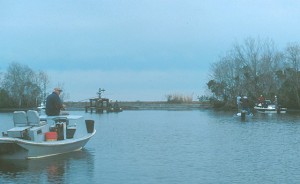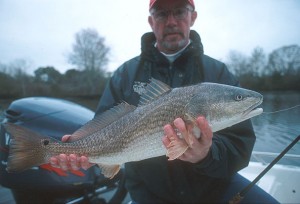Advertisement
Advertisement
Cold-natured Redfish
Louisiana winter, still a scene of redfish plenty
January 31, 2002

Lafitte guide Theophile Bourgeois holds one of the hardy redfish readily caught at this time of the year in the south Louisiana canals.
LAFITTE, La. — This delta dawn was ominous: Gray monotonous skies, temperatures dropping into the 30s along with a fast-moving cold front. The water ebbing into the pipeline canals was just 3 feet deep. The marsh — muck.
Somewhere beneath the surface, redfish were huddled together.
Guide Theophile Bourgeois pointed toward the canal bank. "They'll be feeding within 15 feet of the shore," he said, casting a black-and-chartreuse plastic cockahoe minnow and working it back at a medium pace with a slight pop of the rod tip.
A redfish nailed the plastic. Then another. Then another.
They should call this the Big Easy.
My partner, Spud Woodward, and I watched as Bourgeois dragged a dozen 15- to 20-inch redfish through the tea-and-honey bayou water. A half-hour later, our own skills were honed and the fish were literally dancing to the boat.
"There's just too much fish to leave here," said Bourgeois, a guide for seven years and a south Lousiana native (you might have to guess that with a name like Theophile [Tow-feel] Bourgeois). "We guarantee: No fish. No pay. This is the only place I can put my money up behind that."
Lafitte is also a place full of two-lane-road charm, though it's only 30 minutes south of bustling, bawdy New Orleans. You can stay at Bourgeois' rustic camp south of town or at a local B&B. Three mom-and-pop restaurants will cook you up a mess of fried fish, simmer you some etouffee and serve you local delicacies such as soft-shell crabs.
In winter, conditions can get bitter, but Lafitte remains mostly uncrowded and the fishing is stellar.
Pipeline Canals
When winter's north winds blow water out of the bays and marshes, fish stack up in the miles of connecting canals. These waterways, called the Texaco Canals, were dug for oil pipelines in the 1930s and '40s. Although the water level is quite low right now — 2-4 feet — the fish find subsistence food along the clam-shell bottom.
Not all canals produce. Anglers must search for dead-end canals where the water is clearest, then fish the last 300 yards.
During our February trip, Bourgeois pushed his 21-foot Champion up on plane for the cheek-stinging ride. We crossed Little Bay, spooking flock after flock of wintering ducks.
The first dead-end canal we found held just one boat — one of Bourgeois Charters' three other guides. The second was crowded with skiffs skirting the banks with trolling motors. All seemed to be catching fish, both reds and speckled trout.
"It's a funny hit," Bourgeois commented about the redfish strike. "What it'll be is two things. It's not aggressive. The line will get light or it will feel like you hit a stick.
"If you feel a tap, you know you missed it. Let the bait fall."
Most of the reds and specks are small fish, though the majority of the 30 we caught in our three hours of fishing were legal. A redfish can grow to 14 inches in its first year, adding an inch a month to 18 months. By its fourth year, it can be as much as 27 inches long.
Simple Tackle
Bourgeois' tackle formula involves using 12-pound-test spinning outfits with a 1/4-ounce white- or lead-head jig. The black-and-chartreuse cockahoe or a black shad Bass Assassin are top choices in plastic.
And yes, it is that simple. Louisiana anglers probably wouldn't know a live-bait hook if they saw one. These delta waters are just too bountiful.
By late morning, we had found some privacy, our own wet cul-de-sac. Bourgeois plied the eastern bank and quickly set the hook on a trout. The fish showed at the surface then ejected the lure.
"There goes your trout aaamondeeen," he said dipping into his Cajunese. But the plate would not go empty. Moments later, another trout obliged.
"Sometimes you come in here and every fish you catch is legal. You get tired of catching 'em," Bourgeois said, releasing his umpteenth redfish of the day. He finally laid his rod down and watched as we pitched under overhanging bank brush and around submerged snags.
Tasty Rewards
Lafitte's best months are March through November — a decidedly large spread of time. The winds push up from the south and the water fills the bays with fresh life.
But don't discount the winter. Although we released most of our redfish and trout, we brought a bucketful back to the C-Way Marina just as a trickle of rain began to fall.
Bourgeois hauled out his electric knife — a necessity in fish-rich Lafitte — and fileted several for our lunch. Then he sent us up the road to Jan's where minutes later the waitress delivered us a steaming plate of fresh, fried fish.
Now that's good fishing and good eatin' cher.
For more information on Bourgeois Charters, call (504) 341-5614 or (504) 546-8254 (beeper); or visit the website at www.neworleansfishing.com.
Advertisement
Advertisement














